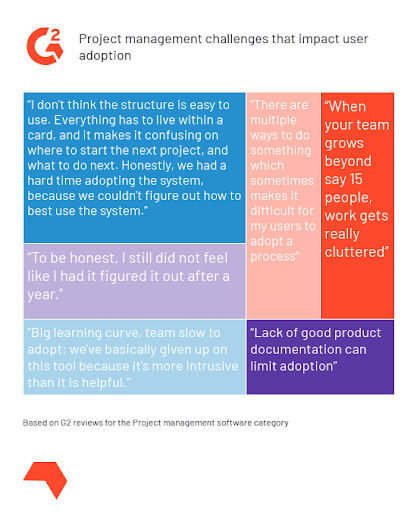New technologies like the cloud have democratized project management software, making it accessible to everyone. Theoretically, a wide variety of options can be beneficial to buyers. Also, a competitive market means that vendors constantly try to outperform their competitors by improving their products. Does it mean that there are no issues in the project management software market? The only way to find out is to analyze feedback from more than 30,000 reviewers of project management solutions.
Buyers have mixed feelings about project management software
There are hundreds of project management software products, most of them offering free or very affordable versions, not to mention many other tools that focus on “light” project management (such as task management software)—but this trend is not entirely positive.
Cheaper software is usually less robust and provides basic features that most users outgrow quickly. As a result, 42% of G2 reviewers mentioned that they recently replaced cloud project management software, and 58% replaced spreadsheets, old or in-house systems, and all kinds of Google and Microsoft products such as calendars, documents, even email.
Other than scaled-down versions of project management, more and more vendors are offering modules like resource management, as separate products. Breaking down project management into components that can be used independently makes sense for small companies or departments of larger companies. Instead of buying and using a full project management system, small teams can choose only the components they need.
The challenge in this approach is that different vendors offer separate tools that need to integrate to exchange information and improve collaboration. This can be particularly disruptive for medium and large companies. The lack of a single data repository leads to errors and double work, making it challenging to track projects at each stage of their lifecycle. Furthermore, resource allocation and collaboration across multiple teams from different locations can be difficult to manage.
To address these issues, some vendors developed complex software such as project and portfolio management (PPM), professional services automation (PSA), and project-based ERP. Large companies are still using these types of software, but mid-market businesses cannot afford them and need alternatives.
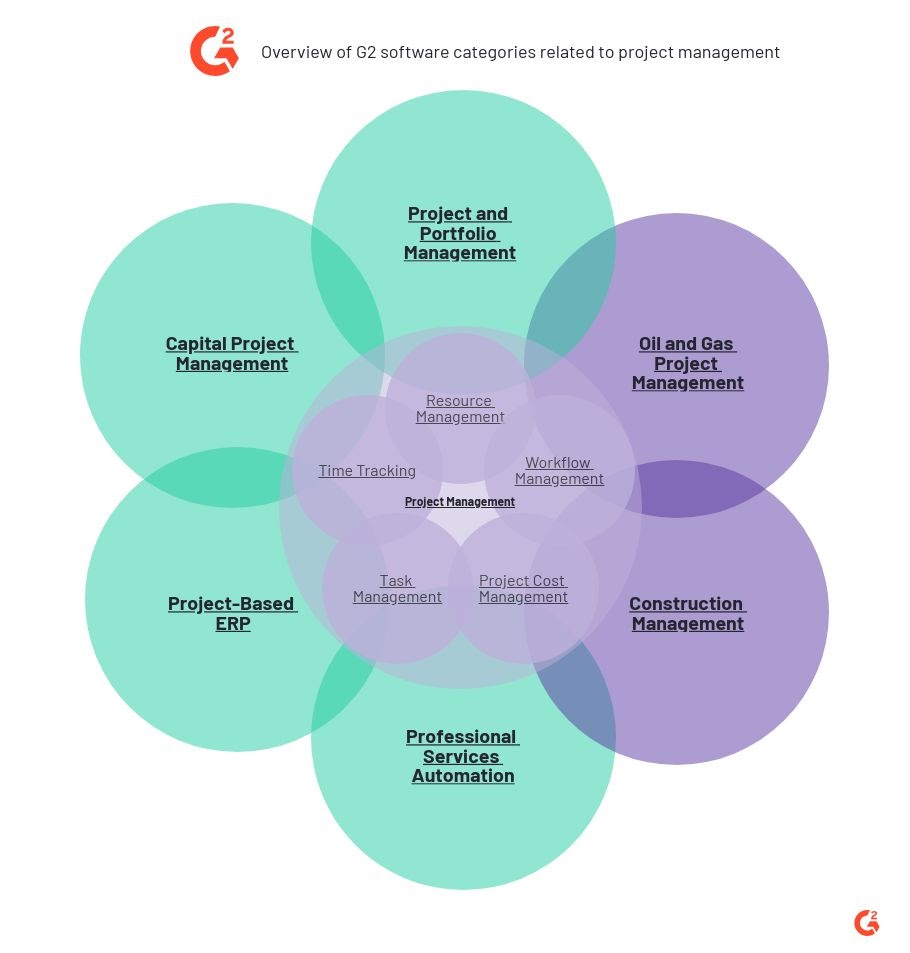
There are also new options for project management, which aim to expand the software's reach to all or most employees.
| The most important new trends in project management development are: |
|
Another alternative to standard project management software is industry-specific solutions. Vertical project management has been around for decades but is evolving to include collaboration features and align with the work management concept described above. The way this type of software is changing varies by industry. Many project management solutions for complex industries, such as architecture, engineering, and construction, are still mostly rigid, complicated, and expensive. On the other hand, agency management software for marketing businesses is less complex and more agile to adapt to the needs of creative professionals quickly.
There is a lot of functional overlap between all these options, making it difficult for buyers to choose the best option for their specific needs. Furthermore, buyers often need to choose between best-of-breed project management, which includes all the features they need and separate tools that can be used together.
To help buyers better understand the pros and cons of the different options, we analyzed more than 30,000 real user reviews that project management software users posted on G2. The most important findings are summarized below.
What buyers think about project management software
At first glance, everything is great in the project management software market: high levels of satisfaction and adoption, hundreds of alternatives to choose from, and many new products delivered in the cloud, making them more affordable and flexible.
Once we analyzed the data by company size and industry, some significant challenges became apparent, such as the robustness of the software, and additional costs required for advanced functionality. Some of the benefits can also be challenges:
- Too much flexibility can be confusing for inexperienced users
- The high number of products available makes it difficult for buyers to compare and select the best option
Does project management software meet user requirements?
Project management users are satisfied and very satisfied with their software. 80% of respondents gave high and maximum Satisfaction scores when reviewing project management software. G2 tracks user satisfaction by asking reviewers to rate the criterion Meets Requirements on a scale from 1 to 7, where 7 is the maximum score. When analyzing the data by company size, we noticed that satisfaction varies by segment, as shown below.
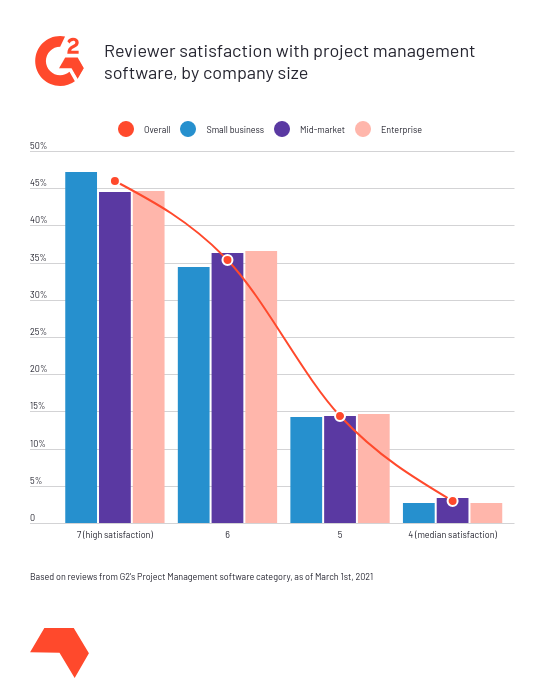
Small business users gave more maximum scores for Meets Requirements and the highest star ratings (5 out of 5) than the other segments. This is not surprising since most project management tools, especially the new ones, offer standard features that are most beneficial for small businesses. It is much more efficient to launch a product that delivers basic features and develop it further depending on the requirements of the customers. The challenge with this strategy is that it creates an inflated market for small businesses, while mid-market buyers need to invest in additional development.
Finally, user satisfaction depends on the development stage of each product. Many new products are still limited in functionality, while old products haven't completely adapted to new technologies such as the cloud or mobile. Since old products tend to be rigid, adding collaboration functionality is difficult. New products facilitate collaboration but don't always include robust features for resource management, task dependencies, or analytics.

The need for additional features and services has a direct impact on the cost of project management software.
How much does project management cost?
When it comes to pricing, most G2 reviewers consider project management software reasonably priced but not always affordable. Most respondents gave scores of 4 and 5 for pricing, on a scale from 1 to 7 where 1 is the least expensive and 7 the most expensive.
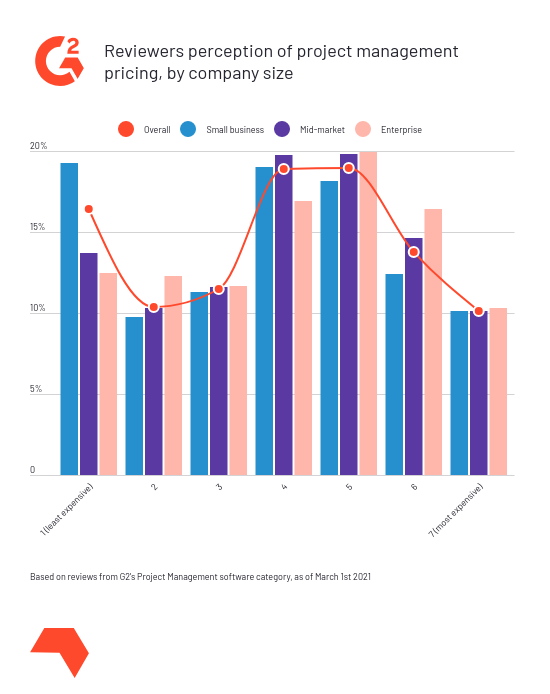
It may seem surprising that enterprise users gave mostly scores of 3 and 4, considering that traditional project management for large companies used to be quite expensive. This can be explained by the fact that the cloud delivery model had a positive impact on pricing in all company segments, not only for small businesses.
The real surprise was that 1 in 3 of mid-market respondents consider their software expensive or very expensive by giving scores between 5 and 7. 40% of small business users express the same concern. This is surprising because the cloud delivery model was initially developed for small and mid-market companies that could not afford to invest in IT infrastructure and qualified personnel.
| Reviewers mentioned that the following factors had the highest impact on pricing: |
|
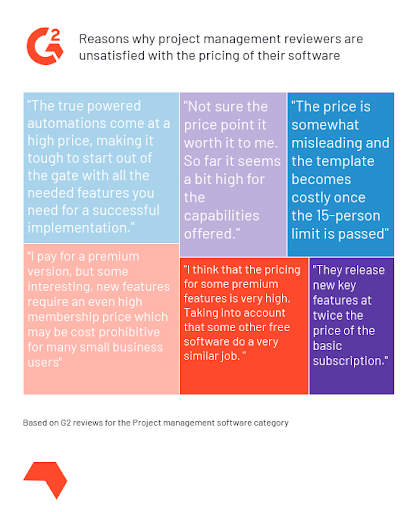
The cost and the level of support for project management features are some of the factors that impact the adoption of this type of software. We analyzed them, and others, below.
What impacts the adoption of project management software?
Adoption levels of project management are evenly distributed—close to 30% of reviewers mentioned adoption levels below 50%, 40% adopted between 50% and 90%, and 32% work for companies that fully adopted their project management software.

As shown above, adoption levels vary by company size, as follows:
- Small companies are more likely to fully utilize project management software (39.46%), and very few users mentioned low adoption levels (less than 10% indicated 0-10% adoption).
- Enterprise companies had the lowest percentage of full adoption (17%), compared with the other company segments, and the highest rate (13.92%) of the lowest adoption level (0-10%).
- Mid-market reviewers gave mixed ratings for adoption levels. Only 21.43% achieved full adoption, and almost 13% achieved an adoption level of under 10%.
- Adoption also varies by industry; while 42% of reviewers from the marketing and advertising industry mentioned maximum adoption, 100% adoption was only achieved by 20% of buyers from construction and healthcare and 22% from manufacturing.
Buyers mentioned a multitude of reasons that impacted adoption, the most important being:
- The software is too complicated or too simple: Old software is usually complex and not very user friendly. Many new tools tend to be too basic for the needs of some users. While simplicity allows users to create anything, like customized workflows, project managers have to do it from scratch, which can be very time consuming.
- Too much or not enough project information, such as notifications and analytics: Some reviewers mentioned that they get an overwhelming amount of information such as email notifications, while others needed to customize their software to get the details they needed.
- New or different features can help users but also confuse them: Several reviewers mentioned that cards create more problems than they solve. While using cards can help visualize projects, using many cards that aren't always related can be counterproductive.
- Training, documentation, and support can be limited or insufficient: This causes the learning curve to be quite steep, and some users may prefer to use other tools that are more user friendly or just more familiar to them.
- Licensing models aren't always straightforward: With different pricing by user type (admin, internal, or external) and extra costs for additional users and features, it can make it difficult for companies to implement the software across the company.
Project management trends
The project management software market changed fundamentally recently, mostly due to the advent of new technologies like the cloud and mobile. These flexible and affordable technologies allowed many small companies to enter the market and helped traditional vendors modernize their solutions. With more than 1000 products listed in G2 categories, project management is one of the most crowded software markets, along with CRM and accounting. While a high number of options is theoretically beneficial to buyers, it can also create confusion and make it difficult to choose the right product.
This confusion also hurts vendors as many of them are having a hard time differentiating their offering from their competitors'. To address this challenge, we expect vendors to take a few different approaches:
- Horizontal specialization through advanced features for resource and portfolio management, as well as strategic planning
- Vertical focus by combining project management with industry-specific features such as proofing and content management for marketing teams and agencies
- Generic approach with standard features for small businesses or small teams of medium to large companies
Other major project management trends are described below.
Remote project management benefits and challenges
On-premises project management made it difficult for users to work remotely. The cloud allows project managers to work from any place with an internet connection, and oftentimes offline. In theory, this means that any cloud project management product enables employees to work remotely. In reality, not all products are created equal, and various factors can make remote work more or less effective.
First, the functionality of the software has a significant impact on the productivity of its users, no matter where they work.
Other important factors that impact remote project management are the licensing model of the system and the level of integration with other software. As companies work with more contractors and freelancers, they need to give them access to their software while also protecting their intellectual property and sensitive data. While most project management vendors offer different levels of access, their pricing isn't always transparent and may significantly impact the software's total cost.
Integration is also critical for remote work because most project managers use other systems such as CRM or accounting software. Synchronizing data across multiple platforms is easier in the cloud but can still be challenging.
Work management aims to redefine the way we work
How many software products do you use at work? Not to mention all kinds of tools for time tracking, workflow management, or resource management. According to research by Blissfully, a company with 35 employees use 102 apps and replaced 63% of its apps in only two years.
Wouldn't it be nice only to use one? Maybe a few? Vendors already tried this with ERP all-in-one, and it did not work well. The ideal would be to have a flexible, not every expensive solution that anyone can use, no matter what they do and where they work. Also, more and more businesses (68% according to PMI) are using contractors and outsourced project managers, who need to be able to use the software provided by the company they work with.
That's precisely what a new type of software called work management aims to deliver. Some vendors refer to it as work OS because it's supposed to be an operating system for the business. This can be achieved by providing a single data repository and an integrated system that is flexible enough for quick and easy configurations. Predefined workflows and processes should also be easy to modify to adapt to any changes in the way a company manages work. Finally, work management should include features complementary to project management, such as customer management, billing, expense management, document management, and collaboration.
As opposed to more complex systems like PPM, PSA, or project-based ERP, work management does not provide full accounting modules, features for project portfolio management, or HR and payroll. Therefore, this type of software still needs to be integrated with other solutions such as accounting software, CRM, and HR suites.
Collaboration is trendy but does it always help?
Project management is collaborative by nature. If you can do everything on your own, you don't need project management. That being said, traditional project management features for collaboration have been rigid and difficult to use. For decades, collaboration was synonymous with assigning tasks and tracking their status. Giving and receiving feedback or sharing documents often required software other than project management. The worst options used for these purposes were FTP file transfer tools, email, and spreadsheets. In the best scenario, companies would use document management software, chat tools, or team collaboration tools. Either way, project managers need to use multiple tools to manage and collaborate on projects.
To address this challenge, some vendors tried to combine traditional project management features and collaboration functionality. These products are known as project collaboration software and can vary significantly in scope and feature set. They all have in common the fact that they focus more on collaboration than on project management. While this is beneficial for casual project managers such as creative teams, they don't cover the needs of advanced users in large companies or project-based industries such as architecture, engineering, and construction.
Too much flexibility isn’t always great
We all want flexible software, but too much configuration can make a solution more difficult to use, not easier. If you're old enough to remember the days when ERP admins used to customize software heavily, you'll understand what I mean. While project management software isn't as complicated as ERP, one of its main benefits is that it offers a structured way to define and track work. When users can create an entirely new structure, some can be very creative while others may be overwhelmed by a "blank slate" software.
Most users may not care much about PMI and project management standards, but admins and project managers should. Those who only want to define and track tasks and don't like spreadsheets can use task management software. Regular users also don't need to worry about rules, workflows, or resource allocation. Administrators need to define and implement a business logic that is consistent with the company's strategy. Robust project management software delivers project templates and workflows with predefined rules that can be customized to the company's needs.
G2 reviewer, Ryan R, founder, marketing and advertising, mentioned this challenge by saying that they don’t like “the ease of making the project over-complex“ (User in Non-Profit Organization Management) or that “you can do just about anything - but that's almost a problem. It's not really set up - out of the box - for any functions.”
Top vendors in the project management market
The project management software evolved tremendously in the past couple of decades. Most vendors did not even exist before 2000. For instance, Asana was founded in 2008 and monday.com in 2012. Of the main players in the global business software market like IBM, Infor, Intuit, Sage, or SAP, only Microsoft and Oracle have products in the top 5 project management products based on reviews by G2 users.
Also, there is a clear differentiation between products focusing on standard features for projects (task management, resource management, project collaboration) and advanced functionality (portfolio management and professional services automation). As shown below, the top 5 products are completely different for standard project management (left) and advanced projects (right).
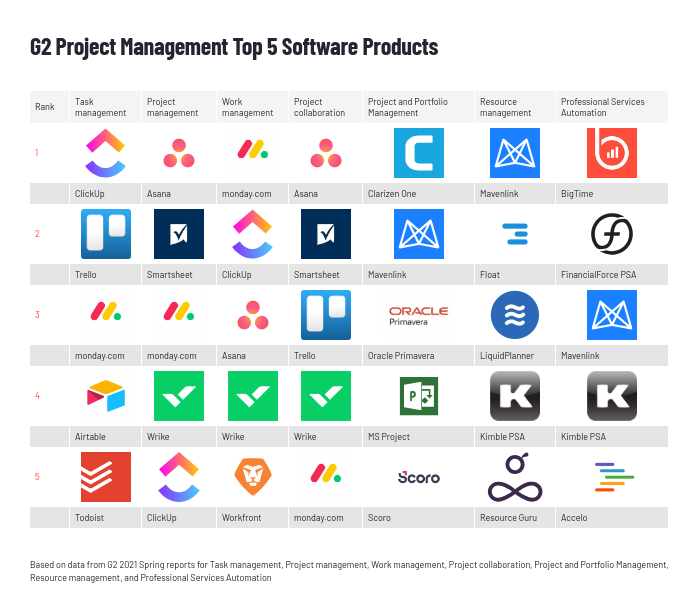
We don’t expect to see major changes in these markets in the short term, except maybe for some major acquisitions. Recent deals include the acquisition of Targetprocess by Apptio (in February 2021) and Workfront by Adobe (in November 2020). Also, the main providers of standard project management software will develop new advanced features and compete with PPM and PSA vendors.
Möchten Sie mehr über Projektmanagement-Software erfahren? Erkunden Sie Projektmanagement Produkte.

Gabriel Gheorghiu
Gabriel’s background includes more than 15 years of experience in all aspects of business software selection and implementation. His research work has involved detailed functional analyses of software vendors from various areas such as ERP, CRM, and HCM. Gheorghiu holds a Bachelor of Arts in business administration from the Academy of Economic Studies in Bucharest (Romania), and a master's degree in territorial project management from Université Paris XII Val de Marne (France).

